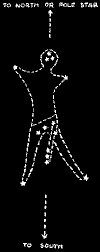By Graham Thomson
Another jolly occupation which comes within the scope of Night Scouting is star-gazing, or astronomy. A Scout must be able to find his way about at night, and when the stars are visible it is easy enough to spot your compass directions from them, if you know a little about them. Besides, it is a fascinating hobby to watch the apparent movements of the various stars, planets, comets and other heavenly bodies, and to learn something about these great worlds that are scattered so brightly about the night sky.
The stars seem to circle over us during the night, but this is really because our earth turns round underneath them. There are various different groups of stars--or they appear to us to be in groups--to which names have been given, usually the names of the men or animals or things that these groups appear to form.
One group, for instance, is shaped rather like a plow, and the Plow [Big Dipper] is an easy star-group, or constellation, to find. It is also the most useful one for Scouts to know, because in the northern half of the world it enables us to know which way is north.
Steering By Stars
The two stars at the front of the Plow are called the Pointers, because they point straight towards the North Star, or Pole Star, a star that is always over the North Pole. All the constellations seem to move round the sky in the course of the night, but the Pole Star does not appear to move at all. It remains fixed in the north, and so it is invaluable as a guide; and you can always find it (since the Pole Star does not look particularly big or bright itself) by finding the Plow’s pointers and following them along to the Pole Star.
Another name for the Plow (Americans call it the Big Dipper, which is their name for a tin cup with a long handle) is Great Bear, and the four stars that form the handle of the Plow are called the Bear's tail. This name must have been given to it by ignorant people, because there is no bear in the world that has a long tail! Still, there it is ; and so you may call the Plow the Great Bear if you like. There is also a Little Bear not far away, and the Pole Star is the last one in the long tail of this group.
There is another constellation that enables you to find the north, and that is the one called Orion. It resembles a man wearing a belt and a sword; you will see three stars in a line like a belt, one close under the end one of them for the hilt of the sword, three in a vertical line below for the sword itself, and three close together above for his head, besides four single stars representing his arms and legs.
If you hold your staff up against the sky to make a line with the sword and the middle of the head, and carry that line on with your eye through two big stars to a third, this third one is the Pole Star.
The special value of Orion is that he can be seen in the southern half of the world as well as the northern, whereas the Plow cannot be seen in the southern half of the world at all.
The Chief tells us, in Scouting for Boys, that the Zulus call Orion's belt and sword the " Ingolubu," or three pigs pursued by three dogs. We call him after Orion, a giant in the ancient tales of the Greeks, who rid an island of wild beasts, and was rewarded after his death by being placed in the heavens.

